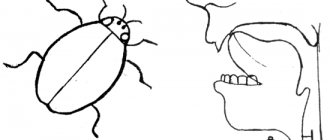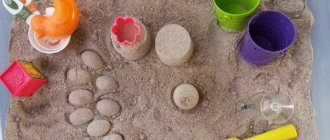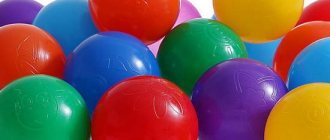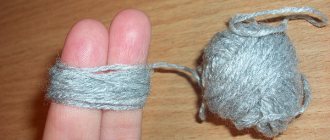Fun "mosaic"
Didactic game. "Fun Mosaic"
Board game for children from 3 to 5 years old.
Purpose of the game:
develop fine motor skills, develop imagination and memory,
the ability to put together various pictures using prepared parts of different colors, repeat the names of colors and their shades, teach children to work independently, choosing pebbles of the required color for this.
Number of players:
2-3 children.
Equipment:
a mosaic set of colored glass, flat pebbles, a playing field, samples of execution or cards.
Material:
a candy box, white plastic bottle caps, PVA glue, multi-colored glass flat stones.
Description of work:
To make the playing field, glue the white caps to the bottom of the box in even rows, close together. The result is a playing field with cells.
Rule of the game:
You can start playing mosaic at 2-3 years old. During the game, be sure to ensure that a small child does not put a flat pebble in his mouth, as this is dangerous. The rules of the game are similar to playing a ready-made mosaic. First, introduce the children to the playing field and the chips - pebbles. Start laying out pebbles in cells with simple ornaments, and then the game begins to take on a creative character in children of middle and senior preschool age.
Tasks:
learn to lay out simple schematic images of objects; strengthen the ability to count within 20; assign names of colors and shades; develop imagination and creativity, spatial arrangement; cultivate patience and perseverance.
Progress of the game:
The teacher invites the children to use a mosaic to make a sun, which is shown in the sample. Next you will need one flat yellow pebble, which should be placed just above the center of the board. This will be the beginning of our sun edge, then we make a circle and fill it with yellow pebbles, then we make rays for the sun.
Options for placing balls in cells:
Laying out simple ornaments.
Laying out according to ready-made diagrams.
Playing homemade mosaics is fun and interesting. As if in between, fine motor skills and speech develop. Children learn perseverance and try to bring the work they start to its logical conclusion.
At the end of the lesson, it is necessary to sum up the results, praising each child for the work done, especially noting those details that were completed on their own initiative.
In the future, you can offer children a game of mosaic with the execution of an arbitrary plot, for example, a house under construction, trees with apples,
Learning to play mosaic. Methodological development on correctional pedagogy (junior group)
Learning to play mosaic.
All parents want to see their children healthy, happy and successful in life. In order for a child to grow up as a harmoniously developed personality, it is necessary to make every effort for his upbringing and development. Games help us with this, because play is the main and leading activity of preschool children. Today there are a huge number of games. Among such diversity, I would like to draw your attention to a fairly simple and, at the same time, very useful game - “Mosaic”.
“Mosaic” is an original, exciting, educational game for children of all ages, combining elements of a construction set, a board game, a puzzle and a creativity kit.
- mosaic develops fine motor skills of the hands
- develops and improves sensory standards (color, shape)
- develops mental processes: attention, memory, thinking, imagination, fantasy, speech
- develops children's cognitive activity
- develops constructive abilities
- develops mathematical abilities in children:
- develops artistic taste in children
- Our task is to teach the child to play mosaic, through which he would develop himself independently.
- Let's start with the fact that before a child begins to develop while playing with mosaics, he needs to be captivated and interested in this game. After all, if you just put a mosaic on the table, he is unlikely to do anything interesting and will soon get tired of it.
- First, introduce your child to the game and its details. As a rule, a game set consists of a field (board, colored elements (chips) and pictures - instructions. Show the children the mosaic board, pay attention to the holes. Take one mosaic element, examine it with the children, show that it has a “hat” and “leg" (“like a mushroom”). The cap of a chip for children 2-3 years old must be hexagonal. Show how to take a chip, teach children to take chips with a pinch: with three fingers - middle, index, thumb, how to insert a mosaic element into the hole of the board. Insert 2-3 mosaic elements. Let the child first try to get the pieces out on his own, if he doesn’t succeed, help: from the back of the board, push the piece so that the cap rises a little. The child’s feeling of success is very important here. And then let him try to insert the elements into the holes.
Can be accompanied by the following game situations:
Game situation “It’s raining” - single placement (i.e. randomly across the entire field)
Game situation “Path” - laying out close to each other (horizontally and vertically)
Game situation “A duck is swimming in a puddle” - laying out close to each other (without gaps)
- Explore the colors of mosaic elements with your children. Lay out the mosaic pieces in front of your child and list the main colors. Pointing to one or another, name the color. You can ask them to sort the chips by color.
- Lay out a path of 3-4 elements in front of your child and ask him to make the same one below, under yours, that is, let him repeat the order of colors. It is necessary to lay out the path from left to right in order to orient the child to the correct letter.
- Gradually increase the number of elements and complexity of the compositions. At the same time, help your child if something doesn’t work out for him, but you shouldn’t assemble the mosaic instead of him. Guide him, suggest the sequence of actions. Be sure to praise your child for his efforts. Rejoice in your child's success with him. And most importantly, convince the child that he can do anything, that he will succeed. It is very important.
MAGAZINE Preschooler.RF
Project on the theme: “Fun mosaic” for children of senior preschool age.Municipal budgetary preschool educational institution "Teremok " Bely Yar
Prepared by: Otegenova K.M.
Teacher 1st category
Project passport:
The origins of children's creativity and talent are at their fingertips. From the fingers, figuratively speaking, come the finest streams that feed the source of creative thought... the more skill in a child’s hand, the smarter the child
Sukhomlinsky V. A.
Project type: creative and informational.
Project duration: short-term
Project participants: children 6-7 years old, teachers, parents of students.
Relevance of the topic:
During the period of preschool childhood, the child develops his first ideas about the world around him, develops the ability to establish the simplest relationships and patterns about the phenomena of life around him, as well as independence in applying the acquired knowledge in accessible practical reality.
Children of the sixth or seventh year of life already have quite extensive knowledge about the world around them.
From observations in the daily life of preschool educational institutions, we see that interest in applications manifests itself in children already from early preschool age, and in older years it becomes more stable. Questioning parents, diagnosing and interviewing children helped to obtain more accurate information about what knowledge children have about the application, what is of greatest interest, and what is available for use. Analysis of the identified ideas about the application showed their partial or complete lack of ideas about its types and methods of working with paper.
After analyzing, I came to the conclusion that there is an urgent need to familiarize children with the world of paper, since paper takes up less and less space in everyday life every year, and the child uses it little. It is also necessary to develop and maintain interest in the application, using the capabilities of the preschool educational institution and the surrounding society.
An insufficient degree of development of technical skills inhibits the work of imagination, fetters children's initiative, and reduces the quality of performance results. Conversely, if a child successfully masters the technical skills of applique operations: tearing, creasing, rolling, twisting and folding paper, this leads to successful mastery of sensory standards; acquiring initial search skills; mastering basic teamwork skills; active communication with each other and the teacher, stimulating a creative attitude to work.
Developed skills and abilities in comparison and comparison, finding the same and distinctive, highlighting the main thing contribute to the accelerated development of analytical and synthetic processes, the ability to combine and transform, which is one of the components of a child’s successful education at school.
Applique classes with directed guidance and using age-appropriate methods and techniques have a great educational and developmental effect.
Project goals:
- Forming knowledge about the origin of paper, understanding the significance in people’s lives, and caring for it.
- Identification of technical skills and abilities in the application process.
- Development of didactic material that has a developmental effect and cognitive stimulation on preschool children.
Project objectives:
- To form basic ideas about paper in 6-7 year old children.
- Expand knowledge about the meaning of paper in human life.
- To develop cognitive activity and mental processes in children. Develop methods of visual and tactile examination of familiar objects.
- Teach technical skills and abilities. Synchronize the work of both hands, coordinate the work of both hands and eyes.
- Teach children to see a complete artistic image in the unity of visual and expressive means (color, shape, size, texture)
- Develop the creative abilities of preschool children.
- Activate and enrich children's vocabulary.
- Consult parents on the development of their children's appliqué abilities.
- To foster curiosity, initiative, interest in applications, independence, activity, and self-confidence.
Expected result:
Children should: gain an understanding of paper, its properties, purpose;
distinguish between types of paper; master technical skills in working with paper;
Development of fine motor skills of the hands; development of analytical-synthetic processes and communication skills.
Working with parents:
Consultations:
“The application helps the child develop”
“The Art of Applique” , “Development of Fine Hand Movements”
Parent meeting:
"Development of creativity in children"
PROJECT IMPLEMENTATION STAGES
1. Preparatory stage
July August
Questioning and interviewing parents and children
Drawing up a long-term work plan for project implementation
Development of criteria for assessing children's skills and abilities
2. Main stage
- September
- Work planning
- Formation of topics for classes
- Diagnostics of children
- Conducting classes
3. Final stage
- October
- Exhibitions of children's works
- Exhibitions of joint works of children and parents
- Photo-exhibitions “Talented Hands”
- Diagnostics of children.
- Project activity product
- Photos of classes
- Children's works
- Models of classes
- Multimedia presentation
FORMS AND MEANS OF WORK
Shapes:
- Classes
- Educational games that contribute to the implementation of the project
- Excursions
- Experiments
- Holidays and entertainment
Facilities:
- Quizzes
- Artistic word
- Music
- Dynamic breaks, physical exercises
- Finger games
- Film library
- Didactic games
Problem:
- Development of hand motor skills by working with different types of paper.
- Introduction to types of paper
- Production of manuals during the project implementation
- Photo bank
- Slide show
- Corner “Talented Hands”
- Album “Types of paper”
- Selection of artistic words for the implementation of the project
- Development of educational games
- Choose correctly
- Cutting pictures
- Paired pictures
- Where and what kind of paper is needed
| Next > |
Didactic game on mathematics in kindergarten for children 4-6 years old. Geometric figures
Didactic game in mathematics for preschoolers “Geometric mosaic”
The didactic game “Geometric Mosaic” is aimed at consolidating knowledge of geometric shapes such as square, rectangle, triangle, circle, oval, rhombus, pentagon and hexagon. The game promotes the development of fine motor skills of children's hands, communication abilities, logical thinking, memory, imagination, as well as the development of the ability to name and select geometric shapes from a variety, analyze the position of an object in space, teaches to compare geometric shapes with a model, develops attention and thinking, and It also teaches children to create images from geometric shapes by overlapping. During the game, children learn to create images from geometric shapes. The game also instills in children patience and perseverance, a desire to finish what they start. Children's age is from 4 to 6 years.
Objectives: - Develop knowledge of primary colors and their shades. Strengthen the ability to arrange in a row according to a pattern. Develop fine motor skills of the hands. Reduce psychophysical stress. Equipment: Laces, a large number of beads made of cardboard in the form of geometric shapes with two holes, sample handout cards.
This is the first stage, where children are offered a card with three geometric shapes: two shapes of the same shape and color, and one of a different shape and color.
The second stage, where there are three geometric shapes of different shapes and colors.
The third stage, where there are four figures. They are different in color and shape.
Fourth stage . Geometric shapes are the same in color, but different in shape. Two assembly options are possible: “Collecting beads” and “Overlaying”
Game description: Children are offered a choice of any card. The child independently, following the example, “collects beads” on a cord, that is, if it is shown on the card, then the child says out loud: red diamond, green circle, blue square, yellow triangle. Performs actions (“collects beads on a cord”). It should look like this: At the end of the game, the child must compare with the sample card. If the child manages to “collect the beads” well and quickly, then the game can be complicated, that is, adding another sample card. My kids love playing this game! The teacher offers to collect the named figures. All figures are mixed. The child must select figures of only the named shape. 1. The teacher invites the children to look at a large card and answer the question: “What geometric shapes is the pattern on the sample made of?” Then the children determine what color the figures are and where they are located. After this, the child selects the necessary geometric shapes and lays out exactly the same pattern. (If it is difficult for a child to complete a task, then we use the method of overlaying figures). Sample cards.
If the child does well, then you can ask him to perform the same pattern from memory. You can invite your child to make his own pattern.
Another option for children who don't know colors. Figures of the same shape, but of different colors with bells are offered. Children should ring the bell that the teacher ordered in advance.
The same task is given to the child if he does not know the geometric shape.
We recommend watching:
Mathematical games with Cuisenaire sticks for children 6-7 years old Mathematical games with geometric figures for children 5-7 years old Mathematical fairy tale - a game for children of the preparatory group of preschool educational institutions Didactic games in mathematics for children 4-6 years old
Similar articles:
Exercises with counting sticks for preschoolers
Math problems jokes for preschoolers
Mathematical riddles for preschoolers in verse with answers
Games for the development of elementary mathematical concepts in preschoolers 3-5 years old
Games with geometric shapes for children 4-6 years old
Lesson at the preschool educational institution “Geometric mosaic”
- November 26, 2011
Competition “My Pedagogical Initiative - 2011”
Nomination “Methodological work in preschool educational institutions”
The main goal of the teacher, in my opinion, is to create conditions for a comfortable stay for the child. What does this mean? The child goes to kindergarten with pleasure, he is welcomed and loved there. There he learns a lot of interesting things and does his favorite thing - playing. It is in the game that his acquaintance with the world around him takes place.
I have always been interested in working with children, but, like any teacher, I have my own preference - mathematics. I wanted the children to love her as much as I did. Mathematics has unique opportunities for children's development. It not only “puts the mind in order,” but also forms personal qualities that are vital for every person: attention and memory, thinking and speech, accuracy and hard work, algorithmic skills and creativity. Participation in mathematical games arouses a keen natural interest in children.
The work submitted for the competition includes a lesson summary and a presentation on the topic “Geometric mosaic. The Adventures of Cheburashka.
Classes are based on the integration of educational areas:
- cognition (FEMP, communication)
- design
- artistic work
- socialization.
Lesson objectives:
- Learn to classify and systematize geometric shapes.
- To teach independence when choosing a way to compare an object and the shape, color of a geometric figure.
- Develop the ability to combine, spatial understanding and imagination.
- Develop speech, attention and memory.
- Develop design skills and directed imagination.
- Practice constructing various objects from geometric shapes according to the proposed drawing.
- Strengthen the ability to find dependencies and patterns, the ability to foresee the results of one’s actions, the ability to find errors and shortcomings.
- Cultivate kindness, sensitivity, and the desire to help.
Equipment
Cheburashka toy; game “Select by color and shape”; drawing of Cheburashka from geometric shapes; a computer with a TV connected as a monitor; presentation file for the lesson; for children: sets of geometric shapes, white sheets of cardboard in A4, A5 format, drawings of objects from geometric shapes, glue, brushes, napkins, oilcloths.
1. Lesson summary “Geometric mosaic. The Adventures of Cheburashka"
Presentation “Geometric mosaic. The Adventures of Cheburashka.
Author: Kalinina Irina Anatolyevna, teacher of the highest category, MBDOU Kindergarten No. 65 “Swallow”, Mytishchi, Moscow region. Work experience in kindergarten for 12 years.
How to do mosaics with a child
You don’t need any special skills to practice mosaics with your child, just be there, help and encourage the child.
And of course, under no circumstances leave a child alone with a mosaic, especially children under 3 years old, and even older if you have concerns that he may take the pieces into his mouth or put them in his nose or ears.
I printed several templates for the mosaic: a car, a helicopter, a boat, a tank, a flower, an apple, etc. I laminated the sheets for strength and cut them into sample cards.
Mosaic activities for children
Mosaic activities for children
Mosaic activities for children
The child really liked these pictures - samples and he enjoyed collecting more and more new images.
In addition, while working with mosaics, you can also practice counting. Together we counted the colored “cubes” in each row in the sample picture and then laid out the same number of colored mosaic elements on the playing field.
Using the “Fun Construction” mosaic constructor in educational work with preschoolers
Bibliographic description:
Matveeva, E. Yu. Using the mosaic constructor “Fun Construction” in educational work with preschoolers / E. Yu. Matveeva. — Text: direct // Questions of preschool pedagogy. — 2020. — No. 1 (28). — P. 35-37. — URL: https://moluch.ru/th/1/archive/150/4781/ (access date: 11/21/2021).
...Game is the spark that ignites the flame of inquisitiveness and curiosity
K. D. Ushinsky
What do children love most? Of course, play! Play for a preschooler is the leading activity. Through play, the child understands how everything should be arranged and learns about the world around him.
One of the options for an exciting, educational and educational game is the game “Fun Construction”. After all, this is not only a mosaic, but also, no less, a construction set. With its help, you can build not only flat figures (as when playing classic mosaic), but also three-dimensional ones. This is achieved due to the fact that the parts are connected both in the horizontal plane using grooves and protrusions, and vertically, sliding on one another. There is no field in this mosaic; it can be assembled on any surface. The game has advantages, and even unique properties that other mosaics and constructors do not have. From the puzzle set you can assemble flat figures that do not fall apart when picked up. Thanks to this, they can be moved from place to place. And you can build three-dimensional figures that can also be moved from place to place. Moreover, with the help of this game you can build multi-story buildings of any configuration. This feature makes this mosaic constructor stand out among other constructors.
“Fun Construction” is just a godsend for those children who love mosaics and LEGO-type construction sets, because this game combines the features of both. Playing with mosaics with a construction set is interesting and useful for children, it develops imagination, spatial and figurative thinking, fantasy, promotes the development of fine motor skills of the fingers, speech development, and cultivates attentiveness and perseverance in preschoolers.
Design is a creative process that is carried out through the independent or joint activities of the teacher and children, children with each other, allowing you to spend interesting and useful time in kindergarten. It is very important that the achievements of children’s creative activity can be clearly demonstrated: this increases self-esteem and has a positive effect on motivation for activity and knowledge. Children see the end result of their activities in the form of finished structures, and this elevates them in their own eyes and makes them want to improve their knowledge, skills and personal qualities. Children develop the ability to cooperate with a partner and work in a team. In a game like “Fun Construction”, children learn by playing. And play is a necessary companion for childhood.
I offer several educational games for children, which I use in educational work with my students.
1. “Who has the taller tower?” The goal of this game is that the building must be higher than that of the opponent.
Everyone takes turns throwing a multi-colored die and taking a puzzle of the corresponding color. If the same colors fall out all the time, then you won’t get a high tower.
2. “Collect beads
We lay out a picture from puzzles of a certain sequence. The child needs to complete the chain to make beads, and be able to find a pattern.
3. Creative game “Photo Frame”
We make a photo frame for the face, multi-colored or one-color. Tasks may be different. For example, those who have a frame need to depict an emotion in the frame using facial expressions, and the rest must guess what emotion the driver was trying to portray. Children love to sing a song while holding a frame or recite a poem.
4. Game “Spinner” This game is one of my students’ favorite games, which they invented themselves and actively use it in their independent activities. Once the spinner is built, the children spin it, launch it at each other, and organize competitions. For example, who will launch next? Or, who will spin longer? This game always brings a lot of emotions and joy to children. The game "Spinner" develops the eye and accuracy, and also has a beneficial effect on attention and the ability to concentrate.
5. Game “Doll Furniture” From a mosaic set you can construct various doll furniture: tables, chairs, benches, houses. This game is ideal for role-playing games and fairy tale therapy.
6. Game “Find the Angle” To fix the orientation on the sheet, the children and I also use a mosaic - the “Fun Construction” constructor. To do this, a field of one color is built. We use white color. And we insert the corners of the field with a different color. Puzzles can be changed or placed on top. For example, lay out the top left corner in green, the top right corner in yellow. The bottom left corner is red and the bottom right corner is blue.
The “Fun Construction” mosaic construction set has become one of the most favorite types of construction set for my students; they are happy to come up with something new and interesting. The flight of children's imagination is great: it's a flag, a flower, a number or a letter, or a real sword.
Let's play with children as often as possible. After all, play is an excellent source of a child’s physical, spiritual, and emotional well-being. Discover the world with your child. Together is always better than just next to each other!
Literature:
- Paramonova L. A. Children's design and creativity. — M.: Karapuz, 2018
- Feshina E. V. “Lego construction in kindergarten.” A manual for teachers. - M.: Sfera, 2014.
Key terms
(automatically generated)
: game, child, this, constructor, mosaic.







